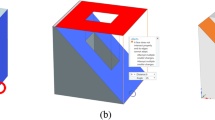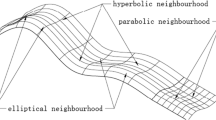Abstract
During product design, the modification of computer-aided design (CAD) models is frequently required. However, modifying a boundary representation (B-rep) model, which is a typical type of CAD model, is difficult and time consuming. To address this problem, we propose a method for modifying B-rep models. In the proposed method, a B-rep model is decomposed into simple volumes by stepwise volume decomposition. A pseudo feature tree called the composition tree is generated with the decomposed simple volumes. A user can modify the B-rep model by transforming or deleting constituents of the composition tree and then replaying the updated composition tree. To demonstrate the proposed method, a prototype system was implemented, and experiments with test cases are performed. Based on the experimental results, we verified that B-rep models could be easily modified using the proposed method.
Similar content being viewed by others
References
Aziz H, Gao J, Maropoulos P, Cheung WM (2005) Open standard, open source and peer-to-peer tools and methods for collaborative product development. Comput Ind 56(3):260–271
Vezzetti E (2009) Product lifecycle data sharing and visualisation: web-based approaches. Int J Adv Manuf Technol 41(5–6):613–630
Alemanni M, Destefanis F, Vezzetti M (2011) Model-based definition design in the product lifecycle management scenario. Int J Adv Manuf Technol 52(1–4):1–14
Tran TA, Park JY (2014) Development of integrated design methodology for various types of product–service systems. J Comput Des Eng 1(1):37–47
Pratt MJ, Anderson BD, Ranger T (2005) Towards the standardized exchange of parameterized feature-based CAD models. Comput Aided Des 37(12):1251–1265
Kim J, Pratt MJ, Iyer RG, Sriram RD (2008) Standardized data exchange of CAD models with design intent. Comput Aided Des 40(7):760–777
Cheon S-U, Kim BC, Mun D, Han S (2012) A procedural method to exchange editable 3D data from a free-hand 2D sketch modeling system into 3D mechanical CAD systems. Comput Aided Des 44(2):154–161
Choi G, Mun D, Han S (2002) Exchange of CAD part models based on the macro-parametric approach. Int J CAD/CAM 2(1):13–21
Mun D, Han S, Kim J, Oh Y (2003) A set of standard modeling commands for the history-based parametric approach. Comput Aided Des 35(13):1171–1179
Kim B, Han S (2007) Integration of history-based parametric translators using the automation APIs. Int J Prod Lifecycle Manag 2(1):18–29
Rappoport A (2003) An architecture for universal CAD data exchange. Proceedings of ACM Symposium on Solid Modeling and Applications 2003, Seattle, pp 266–269
Kim YS (1992) Recognition of form features using convex decomposition. Comput Aided Des 24(9):461–476
Kailash S, Zhang Y, Fuh J (2001) A volume decomposition approach to machining feature extraction of casting and forging component. Comput Aided Des 33(8):605–617
Woo Y, Sakurai H (2002) Recognition of maximal features by volume decomposition. Comput Aided Des 34(3):195–207
Litte G, Clark D, Corney J, Tuttle J (1998) Delta-volume decomposition for multi-sided components. Comput Aided Des 30(9):695–705
Lu Y, Gadh R, Tautges T (2001) Feature based hex meshing methodology: feature recognition and volume decomposition. Comput Aided Des 33(3):221–232
Tang K, Woo T (1991) Algorithmic aspects of alternating sum of volumes. Part 1: data structure and difference operation. Comput Aided Des 23(5):357–366
Kim YS, Wilde DJ (1992) A convergent convex decomposition of polyhedral objects. J Mech Des 114(3):468–477
Sakurai H (1995) Volume decomposition and feature recognition, part I: polyhedral objects. Comput Aided Des 27(11):833–843
Sakurai H, Dave P (1996) Volume decomposition and feature recognition, part II: curved objects. Comput Aided Des 28(6–7):519–537
Woo Y (2003) Fast cell-based decomposition and applications to solid modeling. Comput Aided Des 35(11):969–977
Woo Y, Lee SH (2006) Volumetric modification of solid CAD models independent of design features. Adv Eng Softw 37(12):826–835
Kim I, Han S (2012) Generation of design history from B-rep models by mapping and sequencing of design features. Adv Sci Lett 10(1):528–532
Zhu H, Menq CH (2001) B-rep model simplification by automatic fillet/round suppressing for efficient automatic feature recognition. Comput Aided Des 34(2):109–123
Koo S, Lee K (2002) Wrap-around operation to make multi-resolution model of part and assembly. Comput Graph 26(5):687–700
Author information
Authors and Affiliations
Corresponding author
Rights and permissions
About this article
Cite this article
Kim, B.C., Mun, D. Stepwise volume decomposition for the modification of B-rep models. Int J Adv Manuf Technol 75, 1393–1403 (2014). https://doi.org/10.1007/s00170-014-6210-z
Received:
Accepted:
Published:
Issue Date:
DOI: https://doi.org/10.1007/s00170-014-6210-z




